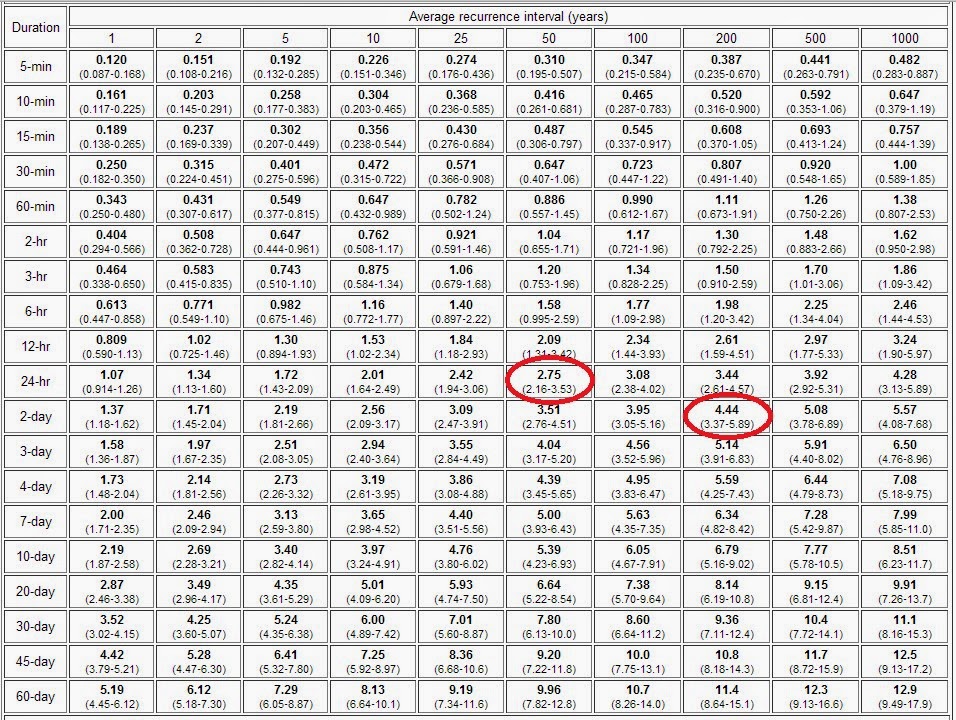A significant rainfall event is winding down across the eastern Interior of Alaska. Many areas east of Fairbanks received in excess of 3" or rain. Figure 1 shows a regional map of precipitation data obtained from the University of Utah's Mesowest Site. Figure 2 shows the data used to make the map.
The 'winner' was the Goodpasture RAWS station. They recorded 2.75" on June 18th and 1.92 on June 19th. The 2.75" in 24-hours has a 50-year recurrence interval and the 4.67" in 48-hours is slightly more than the 200-year recurrence interval. Figure 3 shows the
Figure 1. Map showing 5-day precipitation totals in the Eastern Interior of Alaska. All data was obtained from the University of Utah's Mesowest Site.
Figure 2. Table showing 5-day precipitation totals in the Eastern Interior of Alaska. All data was obtained from the University of Utah's Mesowest Site. Two values highlighted in red are questionable and were excluded from the map.
Figure 3. Precipitation recurrence interval table for the Goodpasture RAWS station. Data obtained from here.



Good presentation Brian. I had just under 2.5" in my USFS rain gauge after it was done (mid-Fairbanks). More's on the way Saturday. Trees are happy, happy, happy.
ReplyDeleteIn the mid-70's I worked out of Coldfoot during pipeline construction doing environmental monitoring. The river training spur dikes were constructed I "think" around a 100 year floodplain. Might be off a few years there, but the builders soon learned that the major rivers could and did exceed their estimates of flow and channel width.
I see there's flooding reported tonight in Interior Alaska...Chena, Salcha, and the Goodpaster rivers. Bad deal for cabin owners and tourists.
Chena River flood control project info: http://waterdata.usgs.gov/ak/nwis/uv/?site_no=15493700&PARAmeter_cd=00065,00060
Gary
Brian, very interesting, thanks. These recurrence interval estimates are useful and worthwhile, but I do always find myself a little skeptical of the numbers and purported confidence levels. The problem is they are often based on rather short periods of record and exclude the possibility of significant multi-decadal or longer change. In Alaska they dropped the 30-year requirement and even produced estimates for some stations with as little as 9-10 years of data. Suppose (for example) the past 20 years have been unusually wet at Goodpasture because of a certain multi-decadal oscillation; then the "true" recurrence interval might be 500 years; or it could be much less if the station history fell in a dry spell. Of course the estimates are useful for comparison between locations and mapping, etc, but I do wonder about their quantitative veracity for prediction. Presumably it is the best we can do with the limited data - and certainly much better than nothing.
ReplyDeleteAnother consideration, although this applies at the basin level and not the point level, is that for the gauging locations on the Goodpaster, Salcha and Chena, this event has been exceeded multiple times, even excluding spring break-up floods. Given the period of record at these sites, this suggests that for the basins (above the gauging points) this was in once every one to three decade type event.
ReplyDeleteAn excellent point Rick. Short period of records can cause havoc with recurrence intervals.
Delete